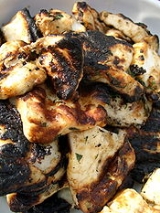
Cuisine of Cyprus
Encyclopedia
.jpg)
Cyprus
Cyprus , officially the Republic of Cyprus , is a Eurasian island country, member of the European Union, in the Eastern Mediterranean, east of Greece, south of Turkey, west of Syria and north of Egypt. It is the third largest island in the Mediterranean Sea.The earliest known human activity on the...
and can be described as a blend of Greek cuisines. Greek Cypriot cuisine is another regional Greek cuisine along with Cretan, Ionian, or Attic.
Modern western cuisine (especially fast food) has an increasing influence on the day-to-day diet on the island. The names given to the foods of the Cypriot cuisine are different amongst the dominant population,the Greeks.
Food preparation

Okra
Okra is a flowering plant in the mallow family. It is valued for its edible green seed pods. The geographical origin of okra is disputed, with supporters of South Asian, Ethiopian and West African origins...
, green bean
Green bean
Green beans , also known as French beans , are the unripe fruit of any kind of bean, including the yardlong bean, the hyacinth bean, the winged bean, and especially the common bean , whose pods are also usually called string beans in the northeastern and western United States, but can also be...
s, artichoke
Artichoke
-Plants:* Globe artichoke, a partially edible perennial thistle originating in southern Europe around the Mediterranean* Jerusalem artichoke, a species of sunflower with an edible tuber...
s, carrots, tomatoes, cucumbers, lettuce and grape leaves, and pulses
Pulse (legume)
A pulse is an annual leguminous crop yielding from one to twelve seeds of variable size, shape, and color within a pod. Pulses are used for food and animal feed. The term "pulse", as used by the Food and Agricultural Organization , is reserved for crops harvested solely for the dry seed...
such as beans (for fasolia), broad beans, pea
Pea
A pea is most commonly the small spherical seed or the seed-pod of the pod fruit Pisum sativum. Each pod contains several peas. Peapods are botanically a fruit, since they contain seeds developed from the ovary of a flower. However, peas are considered to be a vegetable in cooking...
s, black-eyed beans, chick-peas and lentil
Lentil
The lentil is an edible pulse. It is a bushy annual plant of the legume family, grown for its lens-shaped seeds...
s. Pear
Pear
The pear is any of several tree species of genus Pyrus and also the name of the pomaceous fruit of these trees. Several species of pear are valued by humans for their edible fruit, but the fruit of other species is small, hard, and astringent....
s, apple
Apple
The apple is the pomaceous fruit of the apple tree, species Malus domestica in the rose family . It is one of the most widely cultivated tree fruits, and the most widely known of the many members of genus Malus that are used by humans. Apple grow on small, deciduous trees that blossom in the spring...
s, grape
Grape
A grape is a non-climacteric fruit, specifically a berry, that grows on the perennial and deciduous woody vines of the genus Vitis. Grapes can be eaten raw or they can be used for making jam, juice, jelly, vinegar, wine, grape seed extracts, raisins, molasses and grape seed oil. Grapes are also...
s, oranges
Orange (fruit)
An orange—specifically, the sweet orange—is the citrus Citrus × sinensis and its fruit. It is the most commonly grown tree fruit in the world....
, Mandarin orange
Mandarin orange
The orange, also known as the ' or mandarine , is a small citrus tree with fruit resembling other oranges. Mandarin oranges are usually eaten plain or in fruit salads...
s, nectarines, mespila, blackberries
Blackberry
The blackberry is an edible fruit produced by any of several species in the Rubus genus of the Rosaceae family. The fruit is not a true berry; botanically it is termed an aggregate fruit, composed of small drupelets. The plants typically have biennial canes and perennial roots. Blackberries and...
, cherries
Cherry
The cherry is the fruit of many plants of the genus Prunus, and is a fleshy stone fruit. The cherry fruits of commerce are usually obtained from a limited number of species, including especially cultivars of the wild cherry, Prunus avium....
, strawberries
Strawberry
Fragaria is a genus of flowering plants in the rose family, Rosaceae, commonly known as strawberries for their edible fruits. Although it is commonly thought that strawberries get their name from straw being used as a mulch in cultivating the plants, the etymology of the word is uncertain. There...
, figs
Ficus
Ficus is a genus of about 850 species of woody trees, shrubs, vines, epiphytes, and hemiepiphyte in the family Moraceae. Collectively known as fig trees or figs, they are native throughout the tropics with a few species extending into the semi-warm temperate zone. The Common Fig Ficus is a genus of...
, watermelon
Watermelon
Watermelon is a vine-like flowering plant originally from southern Africa. Its fruit, which is also called watermelon, is a special kind referred to by botanists as a pepo, a berry which has a thick rind and fleshy center...
, melon
Melon
thumb|200px|Various types of melonsThis list of melons includes members of the plant family Cucurbitaceae with edible, fleshy fruit e.g. gourds or cucurbits. The word "melon" can refer to either the plant or specifically to the fruit...
, avocado
Avocado
The avocado is a tree native to Central Mexico, classified in the flowering plant family Lauraceae along with cinnamon, camphor and bay laurel...
, citrus
Citrus
Citrus is a common term and genus of flowering plants in the rue family, Rutaceae. Citrus is believed to have originated in the part of Southeast Asia bordered by Northeastern India, Myanmar and the Yunnan province of China...
, lemon
Lemon
The lemon is both a small evergreen tree native to Asia, and the tree's ellipsoidal yellow fruit. The fruit is used for culinary and non-culinary purposes throughout the world – primarily for its juice, though the pulp and rind are also used, mainly in cooking and baking...
, pistachio
Pistachio
The pistachio, Pistacia vera in the Anacardiaceae family, is a small tree originally from Persia , which now can also be found in regions of Syria, Lebanon, Turkey, Greece, Kyrgyzstan, Turkmenistan, India, Pakistan, Egypt, Sicily and possibly Afghanistan , as well as in the United States,...
, almond
Almond
The almond , is a species of tree native to the Middle East and South Asia. Almond is also the name of the edible and widely cultivated seed of this tree...
, chestnut
Chestnut
Chestnut , some species called chinkapin or chinquapin, is a genus of eight or nine species of deciduous trees and shrubs in the beech family Fagaceae, native to temperate regions of the Northern Hemisphere. The name also refers to the edible nuts they produce.-Species:The chestnut belongs to the...
, walnut
Walnut
Juglans is a plant genus of the family Juglandaceae, the seeds of which are known as walnuts. They are deciduous trees, 10–40 meters tall , with pinnate leaves 200–900 millimetres long , with 5–25 leaflets; the shoots have chambered pith, a character shared with the wingnuts , but not the hickories...
, hazelnut
Hazelnut
A hazelnut is the nut of the hazel and is also known as a cob nut or filbert nut according to species. A cob is roughly spherical to oval, about 15–25 mm long and 10–15 mm in diameter, with an outer fibrous husk surrounding a smooth shell. A filbert is more elongated, being about twice...
are some of the commonest of the fruits and nuts
Nut (fruit)
A nut is a hard-shelled fruit of some plants having an indehiscent seed. While a wide variety of dried seeds and fruits are called nuts in English, only a certain number of them are considered by biologists to be true nuts...
.
The best-known spice
Spice
A spice is a dried seed, fruit, root, bark, or vegetative substance used in nutritionally insignificant quantities as a food additive for flavor, color, or as a preservative that kills harmful bacteria or prevents their growth. It may be used to flavour a dish or to hide other flavours...
s and herb
Herb
Except in botanical usage, an herb is "any plant with leaves, seeds, or flowers used for flavoring, food, medicine, or perfume" or "a part of such a plant as used in cooking"...
s include pepper
Black pepper
Black pepper is a flowering vine in the family Piperaceae, cultivated for its fruit, which is usually dried and used as a spice and seasoning. The fruit, known as a peppercorn when dried, is approximately in diameter, dark red when fully mature, and, like all drupes, contains a single seed...
, parsley
Parsley
Parsley is a species of Petroselinum in the family Apiaceae, native to the central Mediterranean region , naturalized elsewhere in Europe, and widely cultivated as an herb, a spice and a vegetable.- Description :Garden parsley is a bright green hairless biennial herbaceous plant in temperate...
, roka
Arugula
Eruca sativa , is an edible annual plant, commonly known as rocket, roquette, rucola or arugula, not to be confused with Wild rocket. It is a species of Eruca native to the Mediterranean region, from Morocco and Portugal east to Lebanon and Turkey...
, celery
Celery
Apium graveolens is a plant species in the family Apiaceae commonly known as celery or celeriac , depending on whether the petioles or roots are eaten: celery refers to the former and celeriac to the latter. Apium graveolens grows to 1 m tall...
, thyme
Thyme
Thyme is a culinary and medicinal herb of the genus Thymus.-History:Ancient Egyptians used thyme for embalming. The ancient Greeks used it in their baths and burnt it as incense in their temples, believing it was a source of courage...
, and oregano
Oregano
Oregano – scientifically named Origanum vulgare by Carolus Linnaeus – is a common species of Origanum, a genus of the mint family . It is native to warm-temperate western and southwestern Eurasia and the Mediterranean region.Oregano is a perennial herb, growing from 20–80 cm tall,...
. Traditionally, artisha (cumin
Cumin
Cumin is a flowering plant in the family Apiaceae, native from the east Mediterranean to India. Its seeds are used in the cuisines of many different cultures, in both whole and ground form.-Etymology:...
) and kolyandro/kolliandros (coriander
Coriander
Coriander is an annual herb in the family Apiaceae. Coriander is native to southern Europe and North Africa to southwestern Asia. It is a soft, hairless plant growing to tall. The leaves are variable in shape, broadly lobed at the base of the plant, and slender and feathery higher on the...
) seeds make up the main cooking aromas of the island. Mint
Mentha
Mentha is a genus of flowering plants in the family Lamiaceae . The species are not clearly distinct and estimates of the number of species varies from 13 to 18. Hybridization between some of the species occurs naturally...
is a very important herb in Cyprus. It grows voraciously, and locals use it for everything, particularly in dishes containing ground meat. For example, the Cypriot version of pastitsio
Pastitsio
Pastitsio , sometimes spelt Pastichio, is a Greek and Mediterranean baked pasta dish including ground beef and béchamel sauce in its best-known form...
(locally known as macaronia tou fournou) contains very little tomato and generous amounts of mint. The same is true of keftedes (meat balls, which are sometimes laced with mint to provide a contrast with the meat.
Cypriots grill over charcoal. The famous souvla. They grill halloumi cheese, olives, mushrooms and loukaniko
Loukaniko
Loukániko is the common Greek word for pork sausage, but in English it refers to the specifically Greek sausages flavored with orange peel, fennel seed, and various other dried herbs and seeds, and sometimes smoked over aromatic woods...
(pork sausages).These are souvlaki
Souvlaki
Souvlaki or souvlakia is a popular Greek fast food consisting of small pieces of meat and sometimes vegetables grilled on a skewer. It may be served on the skewer for eating out of hand, in a pita sandwich with garnishes and sauces, or on a dinner plate, often with fried potatoes...
, sheftalia
Sheftalia
Sheftalia is a traditional Cypriot food. It is a type of crépinette, a sausage without skin, that uses caul fat, or omentum, the membrane that surrounds the stomach of pig or lamb, to wrap the ingredients rather than sausage casing.Caul fat is transparent and naturally fatty...
, or gyros.Gyros is made from various cuts of lamb, pork, or occasionally chicken, and very rarely beef. They are typically served stuffed into a pitta pocket or wrapped in a thin flatbread
Flatbread
A flatbread is a simple bread made with flour, water, and salt and then thoroughly rolled into flattened dough. Many flatbreads are unleavened: made without yeast or sourdough culture: although some flatbread is made with yeast, such as pita bread....
, along with a salad of cabbage, parsley, and raw mild onions, tomatoes and sliced cucumber.Gyros is grilled meat slices instead of chunks, and the taste is made different by the salad or dressings added.
Pourgouri is the traditional carbohydrate other than bread. It is steamed with tomato and onion; a few strands of vermicelli
Vermicelli
Vermicelli is a traditional type of pasta round in section that is thicker than spaghetti.-Vermicelli thickness comparison:In USA, the National Pasta Association, founded in 1904, lists, together with various spelling mistakes, vermicelli as a thinner type of spaghetti.-History in Italy:In...
pasta are often added to provide a texture contrast. Along with pourgouri, natural yoghurt
Yoghurt
Yoghurt, yogurt or yogourt is a dairy product produced by bacterial fermentation of milk. The bacteria used to make yoghurt are known as "yoghurt cultures"...
is a staple. Wheat and yoghurt come together in the traditional peasants' breakfast of tarhana/trahanas, a primitive form of pasta, in which the cracked wheat is steamed, mixed with sour milk, dried, and stored. Small amounts reheated in water or broth provide a very nourishing and tasty meal, especially with added cubes of well-aged halloumi.Pourgouri is also used to make koupes where the bulgur/pourgouri is mixed with flour and water to form a dough, which is formed into a cigar shape. A hollow is made through the cigar and a mixture of minced meat, onions, parsley and cinnamon is packed. After sealing the meat mixture inside the cigar they are deep-fried before serving with lemon juice. For Greek Cypriots, there are many fasting days imposed by the Greek Orthodox Church, and though not everyone adheres, many do. On these days, effectively all animal products must not be consumed. Pulses
Pulse (legume)
A pulse is an annual leguminous crop yielding from one to twelve seeds of variable size, shape, and color within a pod. Pulses are used for food and animal feed. The term "pulse", as used by the Food and Agricultural Organization , is reserved for crops harvested solely for the dry seed...
are eaten instead, sometimes cooked in tomato sauce (yiahni in greek) but more usually simply prepared and dressed with olive oil and lemon. On some days, even olive oil is not allowed. These meals often consist of raw onion, raw garlic, and dried red chili
Chili pepper
Chili pepper is the fruit of plants from the genus Capsicum, members of the nightshade family, Solanaceae. The term in British English and in Australia, New Zealand, India, Malaysia and other Asian countries is just chilli without pepper.Chili peppers originated in the Americas...
is munched along with these austere dishes to add a variety of taste, though this practice is dying out.
Seafood
Popular seafoodSeafood
Seafood is any form of marine life regarded as food by humans. Seafoods include fish, molluscs , crustaceans , echinoderms . Edible sea plants, such as some seaweeds and microalgae, are also seafood, and are widely eaten around the world, especially in Asia...
dishes include calamari, octopus, cuttlefish, red mullet
Red mullet
The red mullets or surmullets are two species of goatfish, Mullus barbatus and Mullus surmuletus, found in the Mediterranean Sea, east North Atlantic Ocean, and the Black Sea. Both "red mullet" and "surmullet" can also refer to the Mullidae in general.Though they can easily be distinguished—M...
parpouni, sea bass
European seabass
The European seabass, Dicentrarchus labrax, also known as Morone labrax, is a primarily ocean-going fish that sometimes enters brackish and fresh waters. It is also known as the sea dace...
lavraki, and gilt-head bream
Gilt-head bream
The gilt-head bream is a fish of the bream family Sparidae found in the Mediterranean Sea and the eastern coastal regions of the North Atlantic Ocean...
(chipura/tsipoura). Octopus, due to its robust nature, is made into a stiffado (stew) with red wine, carrots, tomatoes, and onions. Calamari is either cut into rings and fried in batter or is stuffed whole with rice, cumin, cloves, sometimes adding mint to the stuffing, and then baked or grilled. Cuttlefish (soupies) may be cooked like calamari or like octopus in red wine with onions. It is sometimes prepared with spinach, but without adding garden peas, which are a popular accompaniment for cuttlefish in Turkey, specially in west and south coast, some parts of Greece and Italy. Calamari, octopus, and cuttlefish commonly feature in meze
Meze
Meze or mezze is a selection of small dishes served in the Mediterranean and Middle East as dinner or lunch, with or without drinks. In Levantine cuisines and in the Caucasus region, meze is served at the beginning of all large-scale meals....
, a spread of small dishes served as an appetizer or a meal.
The most traditional fish
Fish (food)
Fish is a food consumed by many species, including humans. The word "fish" refers to both the animal and to the food prepared from it. Fish has been an important source of protein for humans throughout recorded history.-Terminology:...
is salt cod, which up until very recently was baked in the outdoor beehive oven
Beehive oven
A beehive oven is an early type of oven. It gets its name from its domed shape, which resembles that of an old-fashioned beehive, and was in common use in the Americas and Europe from the Middle Ages to the advent of the gas and electric ovens. Beehive ovens were common in households used for...
s with potatoes and tomatoes in season. Gilt-head bream is popular because it is relatively inexpensive and like sea bass extensively farmed. Until recently, salted herrings bought whole out of wooden barrels were a staple food. They are still enjoyed, but not as much now, as fresh fish and meat are regular alternatives.
Vegetables
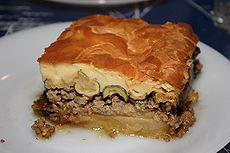
Salad vegetables are eaten at every meal, sometimes whole. More often, they are prepared chopped, sliced, and dressed with lemon and olive oil. In the summer, the usual salad is of celery leaves and stalks, parsley, coriander leaves, tomatoes, and cucumber. Summer purslane is very popular as are wild dandelion leaves
Taraxacum
Taraxacum is a large genus of flowering plants in the family Asteraceae. They are native to Eurasia and North America, and two species, T. officinale and T. erythrospermum, are found as weeds worldwide. Both species are edible in their entirety...
.
In the early spring, artichoke
Artichoke
-Plants:* Globe artichoke, a partially edible perennial thistle originating in southern Europe around the Mediterranean* Jerusalem artichoke, a species of sunflower with an edible tuber...
s are in season. Cypriots eat the leaves by detaching and bitting off the fleshy base. A common preparation for the stalks and the heart is braised with garden peas, with a little onion and perhaps a chopped tomato. Meat is sometimes added.
Bamies (okra
Okra
Okra is a flowering plant in the mallow family. It is valued for its edible green seed pods. The geographical origin of okra is disputed, with supporters of South Asian, Ethiopian and West African origins...
or ladies' fingers) are baked in the oven with tomato and oil, and kounoupidhi (cauliflower
Cauliflower
Cauliflower is one of several vegetables in the species Brassica oleracea, in the family Brassicaceae. It is an annual plant that reproduces by seed...
) is also given this treatment. Cauliflower is also made into moungra, a sour pickle covered with a marinade of vinegar
Vinegar
Vinegar is a liquid substance consisting mainly of acetic acid and water, the acetic acid being produced through the fermentation of ethanol by acetic acid bacteria. Commercial vinegar is produced either by fast or slow fermentation processes. Slow methods generally are used with traditional...
, yeast
Yeast
Yeasts are eukaryotic micro-organisms classified in the kingdom Fungi, with 1,500 species currently described estimated to be only 1% of all fungal species. Most reproduce asexually by mitosis, and many do so by an asymmetric division process called budding...
, and mustard seed
Mustard seed
Mustard seeds are the small round seeds of various mustard plants. The seeds are usually about 1 or 2 mm in diameter. Mustard seeds may be colored from yellowish white to black. They are important spices in many regional foods. The seeds can come from three different plants: black mustard , brown...
s. It is also cooked in tomato sauce, onions and mince meat.
Vazania (aubergine
Aubergine
The eggplant, aubergine, melongene, brinjal or guinea squash is a plant of the family Solanaceae and genus Solanum. It bears a fruit of the same name, commonly used in cooking...
s) can be prepared in a variety of ways, including stuffed and in moussaka
Moussaka
Moussaka is an eggplant based dish of the Balkans, Eastern Mediterranean, and the Middle East. The best known variation outside the region is the Greek one.-Names and etymology:...
. They are commonly fried and stewed slowly in oil, where the cooking time brings out the flavour and also allows them to shed the oil they have absorbed. Turkish cypriots hollow them, fry them, stuff them with tomatoes and garlic or mince meat and tomato paste, cook them in the oven and garnish with parsley.
Meat
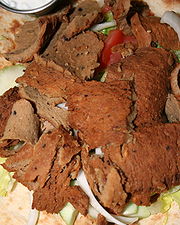
Afelia, when well prepared, is a delicious saute of pork, red wine, and coriander seeds. Psito is large chunks of meat and potatoes cooked in the oven. Plenty of fat is used in its preparation; traditionally, this would have been rendered pig fat, but now sunflower oil is used. Olive oil is used as a dressing for salads, vegetables, and pulses but is not used to cook meat dishes.
Preserved pork meat is very popular, and before refrigeration, it was the main source of red meat available to Greek Cypriots. Cypriots also add red wine; therefore, there is a characteristic flavour to most of the charcuterie from the island.
Lountza
Lountza
Lountza is a meat delicacy of Cyprus of dried, smoked pork tenderloin. The name may come from the Italian lonza stagionata.-Production:To produce lountza, pork tenderloin is first soaked in brine and then marinated in red wine. The marinated tenderloin is then dried and smoked. After smoking,...
is made from the pork tenderloin. After the initial brining and marinading in wine, it is smoked. Although it can be aged, many prefer younger, milder lountza. It is often cooked over coals or fried with eggs to act as a sandwich filler or as part of a meze. Stronger than lountza and made from the leg, is chiromeri, which is similar to any smoked, air-dried ham from Southern Europe, although the wine flavour makes it characteristically Cypriot. In non-mountain areas, the same meat used for chiromeri is cut into strips along the muscle compartments and dried in the sun as basta. The shoulder of a freshly slaughtered animal is cut into chunks about the size of an almond along with a smaller quantity of chopped back fat, which are marinated in wine and brined, stuffed into intestines, and smoked as sausages (loukaniko
Loukaniko
Loukániko is the common Greek word for pork sausage, but in English it refers to the specifically Greek sausages flavored with orange peel, fennel seed, and various other dried herbs and seeds, and sometimes smoked over aromatic woods...
). The Italians have a sausage of the same name.
A traditional practice that is dying out fast is to render pig fat for use as a cooking medium and a preservative. Loukaniko and also chunks of fried salted pork meat and fat can be stored in earthenware jars submerged in the lard for a long time, even in the heat of the island.
Koupes is the Island's variant of what is called Kouba in the Arabic world. It's made from a burghouri grain exterior which is molded into a spherical shape and filled with a mince and onion mixture. The variation from the Arabic version is that the Cypriots use pork instead of beef, as well as the spices. You can find these in any bakery, which would be made fresh in the morning. However for the best Koupes you have to have it straight from the frier! For this you need to visit local pastry shops that will make it for you on order. See below links for some of these.
Lamb and goat meat is also preserved as tsamarella, made very salty to prevent the fatty lamb meat from going rancid. Very popular amongst both communities is preserved beef. The whole silversides and briskets are salted and spiced quite powerfully to make pastourma. The same meat and some fat is chopped finely and made into pastourma-loukaniko sausages.
Many Greek Cypriots consider snails a delicacy. Snails are in season in late autumn, when the first good rains arrive after the hot summer. After being purged, they are either prepared as a pilaf with rice, or cooked in cinnamon, onions and tomatoes as a stifado.
Mezedes
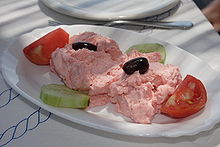
Skordalia
Skordalia or skordhalia/skorthalia is a thick puree in Greek cuisine made by combining crushed garlic with a bulky base—which may be a purée of potatoes, walnuts, almonds, or liquid-soaked stale bread—and then beating in olive oil to make a smooth emulsion. Vinegar is often added...
(potato and garlic dip), humus, taramosalata
Taramosalata
Taramosalata is a Greek and Turkish meze. It is traditionally made from taramas, the salted and cured roe of the cod or the carp, though blends based on other forms of fish roe, particularly cod, have become more common. The roe is mixed with either bread crumbs or mashed potato, and lemon juice,...
(fish roe dip), and tzatziki
Tzatziki
Tzatziki, tzadziki, or tsatsiki is a Greek meze or appetizer, also used as a sauce for souvlaki and gyros. Tzatziki is made of strained yoghurt mixed with cucumbers, garlic, salt, usually olive oil, pepper, sometimes lemon juice, and parsley. Tzatziki is always served cold...
, all served with chunks of fresh bread and a bowl of mixed salad. Some of the more unusual meze dishes include octopus in red wine, snails in tomato sauce, brains with pickled capers, samarella (salted dried meat), quails, pickled quail eggs, tongue, ram's testes, kappari pickles (capers), and moungra (pickled cauliflower). Bunches of greens, some raw, some dressed with lemon juice and salt, are a basic feature of the meze table. The meal continues with fish, grilled halloumi cheese, lountza (smoked pork tenderloin), keftedes (minced meatballs), sheftalia
Sheftalia
Sheftalia is a traditional Cypriot food. It is a type of crépinette, a sausage without skin, that uses caul fat, or omentum, the membrane that surrounds the stomach of pig or lamb, to wrap the ingredients rather than sausage casing.Caul fat is transparent and naturally fatty...
(pork rissole
Rissole
A rissole is a small croquette, enclosed in pastry or rolled in breadcrumbs, usually baked or deep fried...
s), and loukaniko
Loukaniko
Loukániko is the common Greek word for pork sausage, but in English it refers to the specifically Greek sausages flavored with orange peel, fennel seed, and various other dried herbs and seeds, and sometimes smoked over aromatic woods...
(pork sausages). Hot grilled meats – kebabs, lamb chops, chicken – may be served toward the end. The dessert is usually fresh fruit or glyka – traditional sugar-preserved fruits and nuts.
Desserts
Loukoumades(fried doughballs in syrup), Loukoumia, Ravani,Touloumbes,Baklavas are some of the loved desserts.There is also Pastish, a cookie made of ground almonds that are offered to guests at weddings.
Flaounes are savory Easter
Easter
Easter is the central feast in the Christian liturgical year. According to the Canonical gospels, Jesus rose from the dead on the third day after his crucifixion. His resurrection is celebrated on Easter Day or Easter Sunday...
pies that contain goats cheese (or a variety of cheeses), eggs, spices and herbs all wrapped in a yeast pastry, then brushed with egg yolk and dipped into sesame seeds.
Cypriots also make many traditional sweets that are usually made of turunch/ bergamot, figs, tiny aubergines, fresh fleshy walnuts, watermelon or pumpkins processed akin to jam but without the over-cooking. The fruit is soaked for two weeks (depending upon the fruit) then boiled with sugar until the correct texture is obtained.
Cheeses
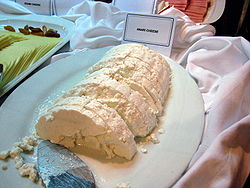
Halloumi
Halloumi is a traditional Cypriot cheese that is also popular in Sweden and the rest of the Middle East and Greece, and is now produced in many countries and regions around the world...
is a semi-hard white-brined cheese with elastic texture, made in a rectangular shape from a mixture of goat and sheep milk; it may be sliced and eaten fresh, grilled, or fried. Aged halloumi may be grated over pasta dishes. It is the national cheese of Cyprus.
Anari
Anari (cheese)
Anari is a fresh mild whey cheese produced in Cyprus. Although much less known than other Cypriot cheeses , it has started to gain popularity following recent publicity exposure...
, from Greek (αναρή) is a crumbly fresh whey cheese
Whey cheese
There are several types of cheese, with around 500 different varieties recognised by the International Dairy Federation, over 400 identified by Walter and Hargrove, over 500 by Burkhalter, and over 1,000 by Sandine and Elliker...
, similar to ricotta
Ricotta
Ricotta is an Italian dairy product made from sheep milk whey left over from the production of cheese. Although typically referred to as ricotta cheese, ricotta is not properly a cheese because it is not produced by coagulation of casein...
, made from goat or sheep milk. Usually unsalted (though salted versions are available), it is sometimes eaten with a drizzle of honey
Honey
Honey is a sweet food made by bees using nectar from flowers. The variety produced by honey bees is the one most commonly referred to and is the type of honey collected by beekeepers and consumed by humans...
or carob syrup.
Drinks
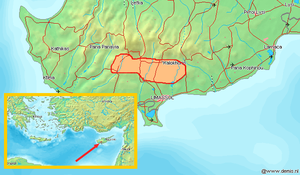
Non alcoholic
Ayrani is a traditional drink made of milk. Its recipe varies from region to region.Triantafyllo, a thick concentrated dark pink syrup (en: Rose cordial) made from the extract of the Cyprus (Damascus) rose, has water or milk added to make a refreshing sweet cordial, especially in summer. It is distinct from rodostagma (lit. rose drops) (rose water) and anthonero (blossom water), which are clear liquids, are used to sweeten machalepi and other sweetmeats.
Alcoholic
Among Cypriots traditional Brandy and Zivania are of the most popular drinks on the island. The second popular drink is beer. The local breweries of KEO and Carlsberg command the lion's share of the market. In the Turkish-controlled areas, EfesEfes Beverage Group
Efes Beer Group was founded in Turkey in 1969, and today consists of sixteen breweries in Turkey, Russia, Kazakhstan, Moldova, Georgia and Serbia, with headquarters in Istanbul. Named after the ancient Greek city of Ephesus located near the İzmir brewery, the company is a subsidiary of Anadolu...
is the most widely sold. Evidence of wine
Cyprus wine
The Cypriot wine industry ranks 37th in the world in terms of total production quantity ., and much higher on a per capita basis. Although, chronologically, Cyprus belongs to the old world of wine producing countries, the industry has gone through changes that place it more on par with the new world...
production on Cyprus —one of the first wine producers— goes back for millennia. Commandaria
Commandaria
Commandaria is an amber-coloured sweet dessert wine made in the Commandaria region of Cyprus on the foothills of the Troödos mountains. Commandaria is made from sun-dried grapes of the varieties Xynisteri and Mavro. While often a fortified wine, through its production method it often reaches high...
, the oldest wine in continuous production, is a popular dessert wine.
Cyprus also has a tradition of brandy
Cyprus brandy
The production of brandy on Cyprus began in the year 1871 by ETKO following their importation of a pot still from Cognac in 1868. Data coming from the English explorer Samuel Baker revealed that in 1875 the volume of native brandy production in the Limassol District alone amounted to 467,711 okes...
production, with production by various Limassol-based distilleries since 1871. Cypriot brandy is commonly drunk with meze dishes, and forms the base for the distinctive brandy sour
Brandy Sour (Cyprus)
The Brandy Sour is a mixed alcoholic cocktail that has been cited as the national drink of Cyprus. While other forms of the Brandy Sour cocktail exist, the Cypriot variety is a distinct mixture, which only shares the basic brandy and lemon flavourings with other variants...
cocktail
Cocktail
A cocktail is an alcoholic mixed drink that contains two or more ingredients—at least one of the ingredients must be a spirit.Cocktails were originally a mixture of spirits, sugar, water, and bitters. The word has come to mean almost any mixed drink that contains alcohol...
, developed on the island in the late-1930s. Zivania
Zivania
Zivania or zivana is a Cypriot alcoholic beverage. Zivania is a distillate produced from the pomace of grapes that were pressed during the wine-making process mixed with local dry wines produced from local grape varieties of Cyprus such as Xynisteri and Mavro...
, a grape distillate similar to raki
Raki
-Alcoholic beverages:*Rakı, an anise-flavored spirit popular in Turkey*Any anise-flavored drink.-Fictional characters:*Raki, a character in the manga/anime series Claymore*Raki, a character in the game Ar tonelico II: Melody of Metafalica...
, is another popular spirit.

